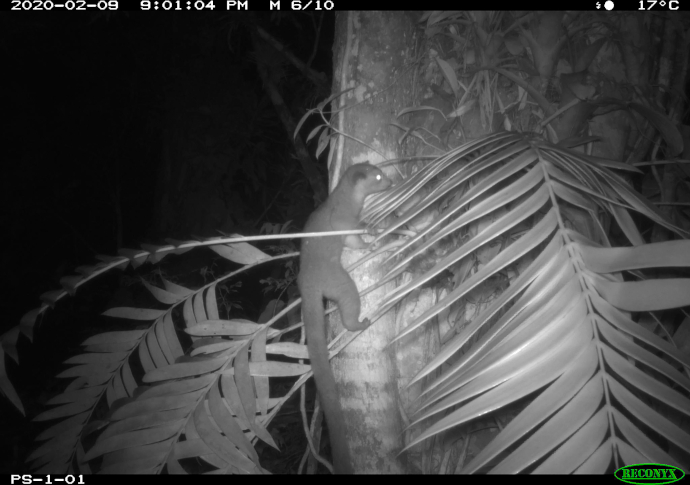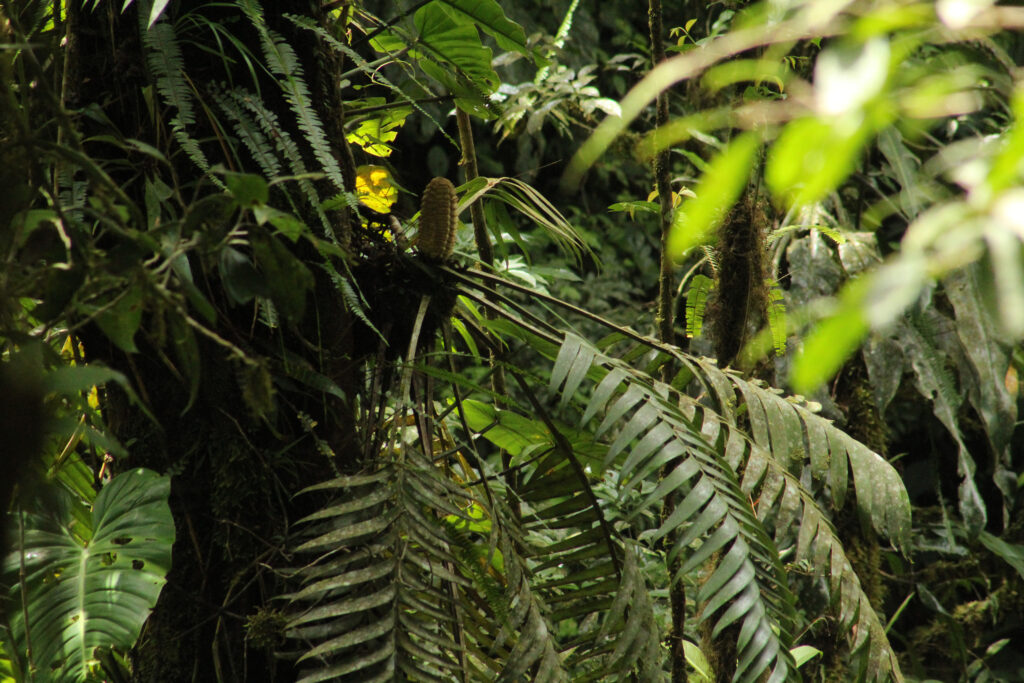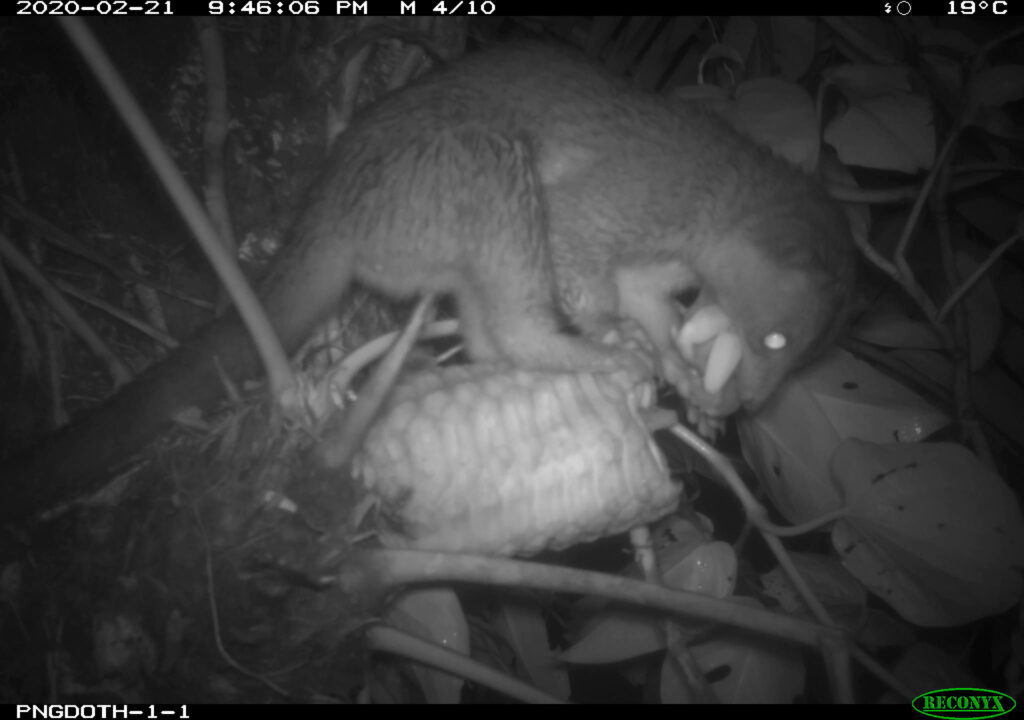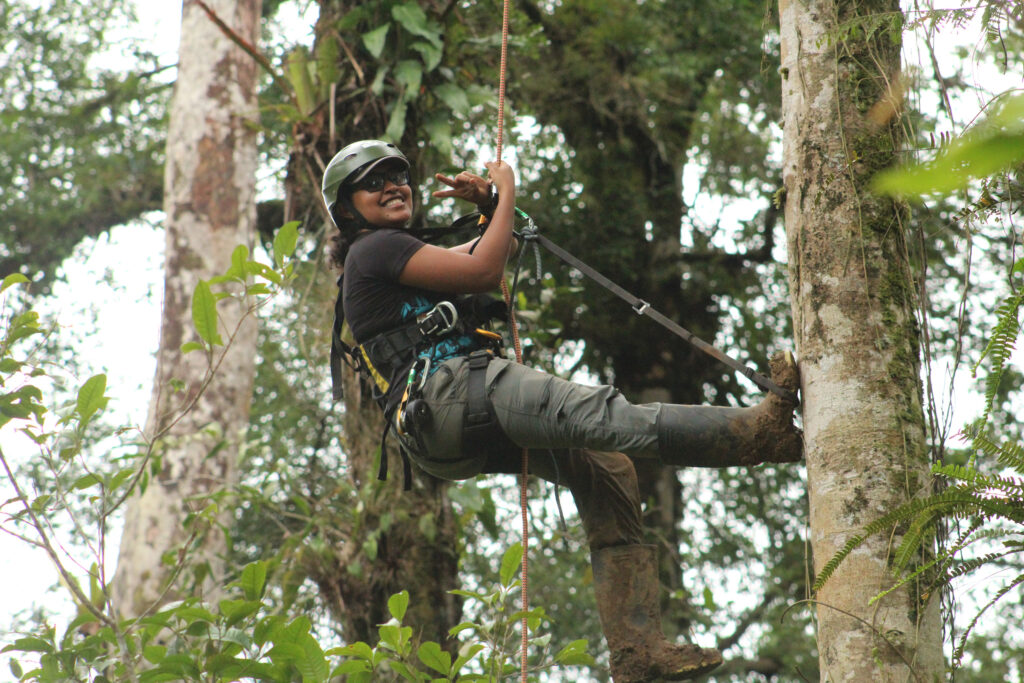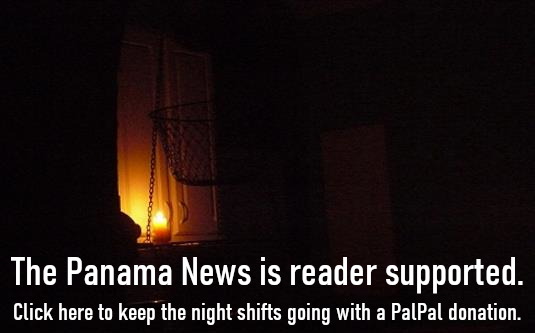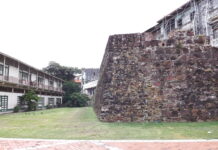The olingo (Bassaricyon gabbii), a nocturnal tree-dwelling mammal, was observed repeatedly inspecting and biting at the immature cones of Z. pseudoparasitica and then taking up to four seeds per occasion once opened. Photo by Claudio Monteza — STRI.
The mystery of an unusual Panamanian plant’s dispersal
by the Smithsonian Tropical Research Institute (STRI)
Sleeping in a car may be a necessity for scientists conducting fieldwork. In 2020, a team of young researchers spent two nights sleeping in their car in the mountains of western Panama. The second time it was not intentional: their car broke down in El Copé, in Coclé province, and they had to wait for a tow truck. At least a woman from the area took pity on them and offered them fried plantains and coffee. A few years and a pandemic later, the study resulting from those adventures was published in the journal Ecology and Evolution, revealing clues about the natural history of an unusual plant that only exists in Panama.
Zamia pseudoparasitica is a unique species that is only found in the montane cloud forests of western Panama. It is a cycad, belonging to a very ancient order of plants that resemble palm trees and produce cones. The genus, Zamia, originated 68.3 million years ago, when there were still dinosaurs roaming the planet. But the most unusual thing about this particular species is that it is the only epiphytic Zamia in the world: it does not grow on the ground, but hangs on to the branches and trunks of trees using its roots, generally 7-20 meters above the ground.
To begin to solve the mystery of how it persists in the canopy, a somewhat fortuitous research team formed. Doctoral student at the Max Planck Institute for Animal Behavior and visiting scientist at the Smithsonian Tropical Research Institute (STRI), Claudio Monteza, and Senacyt-STRI intern and biologist Lilisbeth Rodríguez, ran into each other one day at the Smithsonian research station on Barro Colorado Island, in the Panama Canal. She told him about the project that she was conducting with Z. pseudoparasitica under the supervision of Juan Carlos Villarreal, a biologist from Laval University in Canada, and Kristin Saltonstall, a STRI staff scientist in Panama.
“My goal was to collect samples from different species of Zamias in the country,” Rodríguez said. “These samples would later be analyzed in the laboratory to find out what species of fungi and bacteria grow inside their leaves.”
Her supervisor, Juan Carlos Villarreal, told her that no one knew how this plant’s seeds were dispersed: it was still a mystery. But given her experience climbing trees as part of the project, and aware of Claudio’s work with camera traps to study mammal behavior, Lilisbeth asked to borrow some traps. She wanted to place them high up in the trees to find out what species of animals interacted with the Zamia.
Claudio joined the project, as did Pedro Luis Castillo, a research assistant at STRI, and Edgar Toribio, a tour guide from Santa Fe. At the end of 2019, they placed the camera traps on trees in three protected areas where Z. pseudoparasitica grows: the Palo Seco Protected Forest, the Santa Fe National Park and the Omar Torrijos Herrera National Park in El Copé. In March, shortly before a mandatory quarantine due to the pandemic began, they collected the camera traps.
What they saw in the images could help explain how Z. pseudoparasitica disperses in the trees and not on the ground like other Zamia species. While seven different mammals visited the branches where Z. pseudoparasitica were growing, some paid no attention to the plant; others, such as capuchin monkeys, opossums and kinkajous inspected its cones, some even licked them, but did not take the seeds. Only the northern olingo (Bassaricyon gabbii), a nocturnal tree-dwelling mammal that is active high in the canopy and feeds primarily on fruit, was repeatedly observed at all three sites. When the cones of Z. pseudoparasitica were still closed and immature, they were seen inspecting and biting them. Once opened, the cameras detected the olingos collecting up to four seeds at a time.
“It could be that the olingos are taking the seeds to what would be their den or perhaps to a seed bank,” Monteza explained. “If they are, which we don’t yet know for sure, it would help to explain why this is the only Zamia species that lives in the forest canopy.”
In other words, if the seeds are being stored in the canopy by olingos, chances are they might end up in favorable places for germination up there.
“The montane forests of western Panama are very unique, filled with many species that aren’t found anywhere else,” said Kristin Saltonstall, co-supervisor of the project. “It’s exciting to document this interaction between such a special plant and an animal that is also poorly understood.”
“Z. pseudoparasitica is a true epiphyte; that is to say, it spends its entire life in the forest canopy,” said Monteza. “How it persists there is a mystery that perhaps we will begin to solve with these initial findings. It’s exciting because we can continue to the next phase by collecting more data; for example, it occurs to us that we can mark the seeds with bioluminescence, wait for the olingos to take them away and then search for the seeds at night.”
Zamia pseudoparasitica is the only species of its genus that grows on other trees, but little is known about why it evolved that way. Photo by Pedro Luis Castillo — STRI.
An evening meal in the trees. Photo by Claudio Monteza — STRI.
Given her experience climbing trees, Lilisbeth Rodríguez borrowed some camera traps from Claudio Monteza to place them high up in the trees and discover which animals interacted with Zamia pseudoparasitica. Photo by Claudio Monteza — STRI.
:
Reference: Monteza-Moreno, C.M., Rodriguez-Castro, L., Castillo-Caballero, P.L., Toribio, E., Saltonstall, K. (2022). Arboreal camera trapping sheds light on seed dispersal of the world’s only epiphytic gymnosperm: Zamia pseudoparasitica. Ecology and Evolution 12(3). https://onlinelibrary.wiley.com/doi/10.1002/ece3.8769
Contact us by email at fund4thepanamanews@gmail.com
To fend off hackers, organized trolls and other online vandalism, our website comments feature is switched off. Instead, come to our Facebook page to join in the discussion.
These links are interactive — click on the boxes

